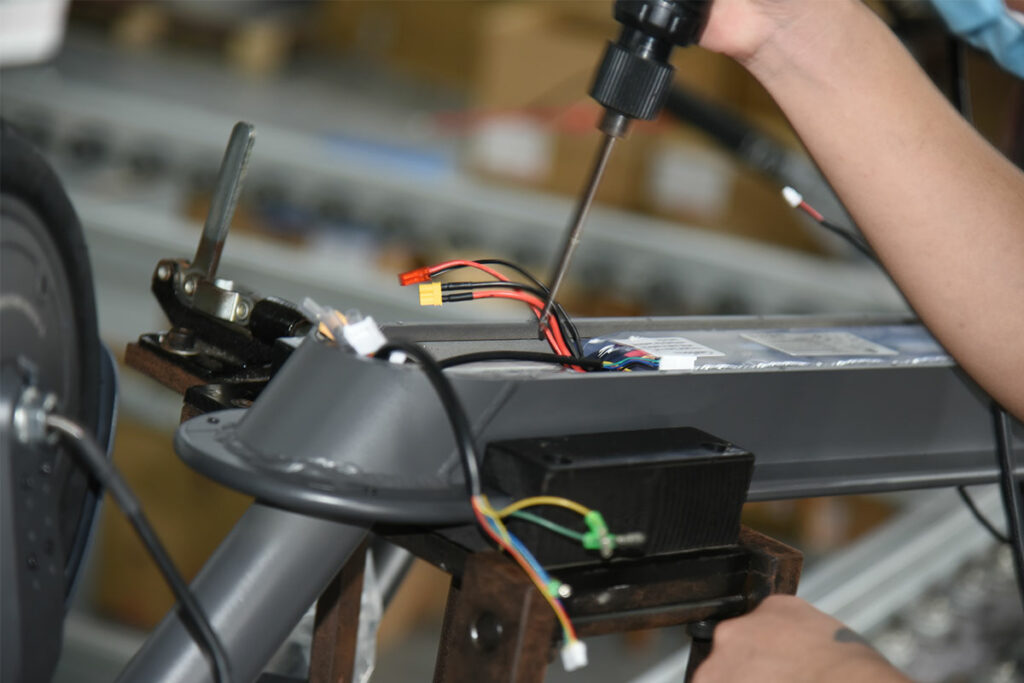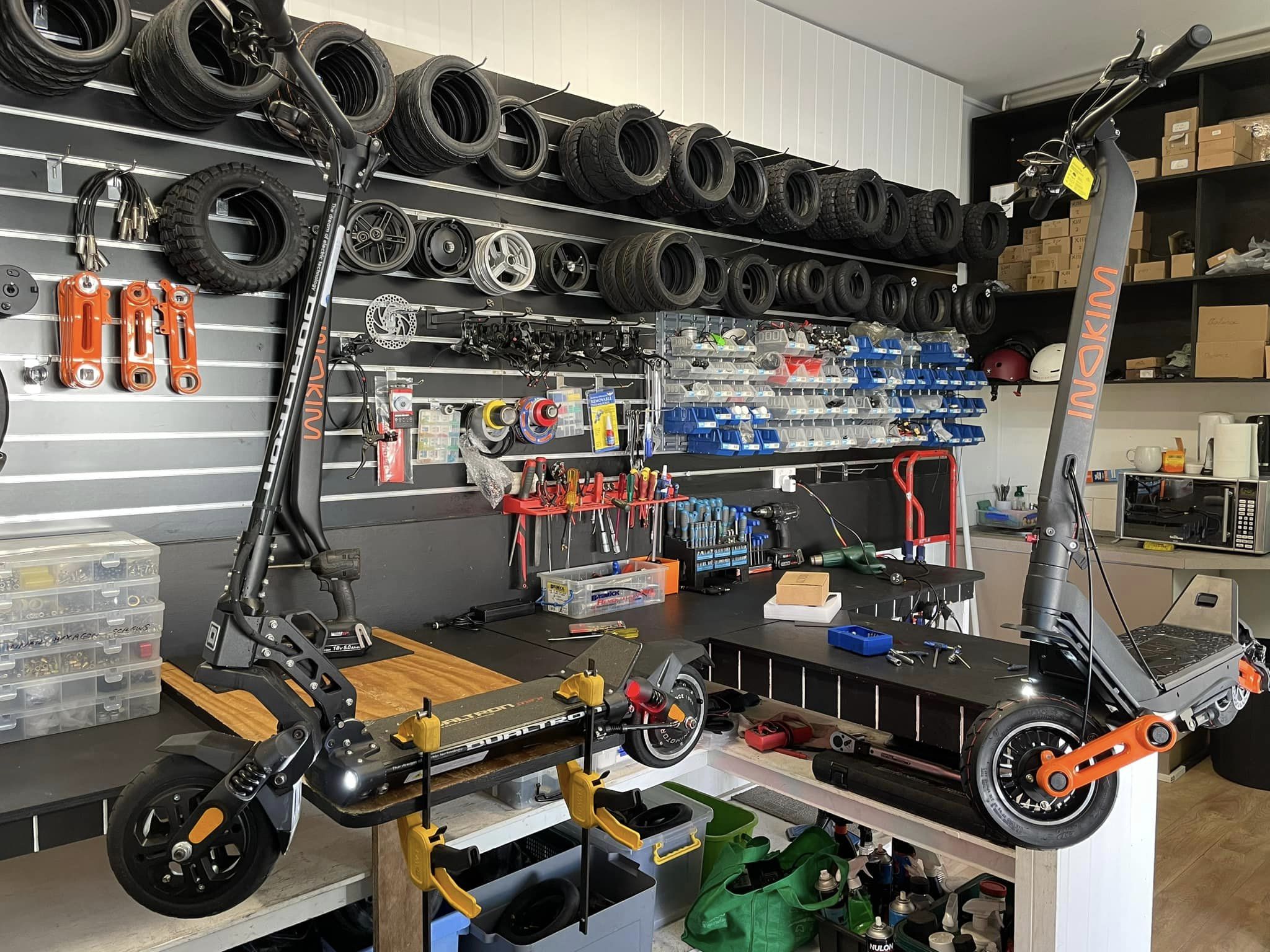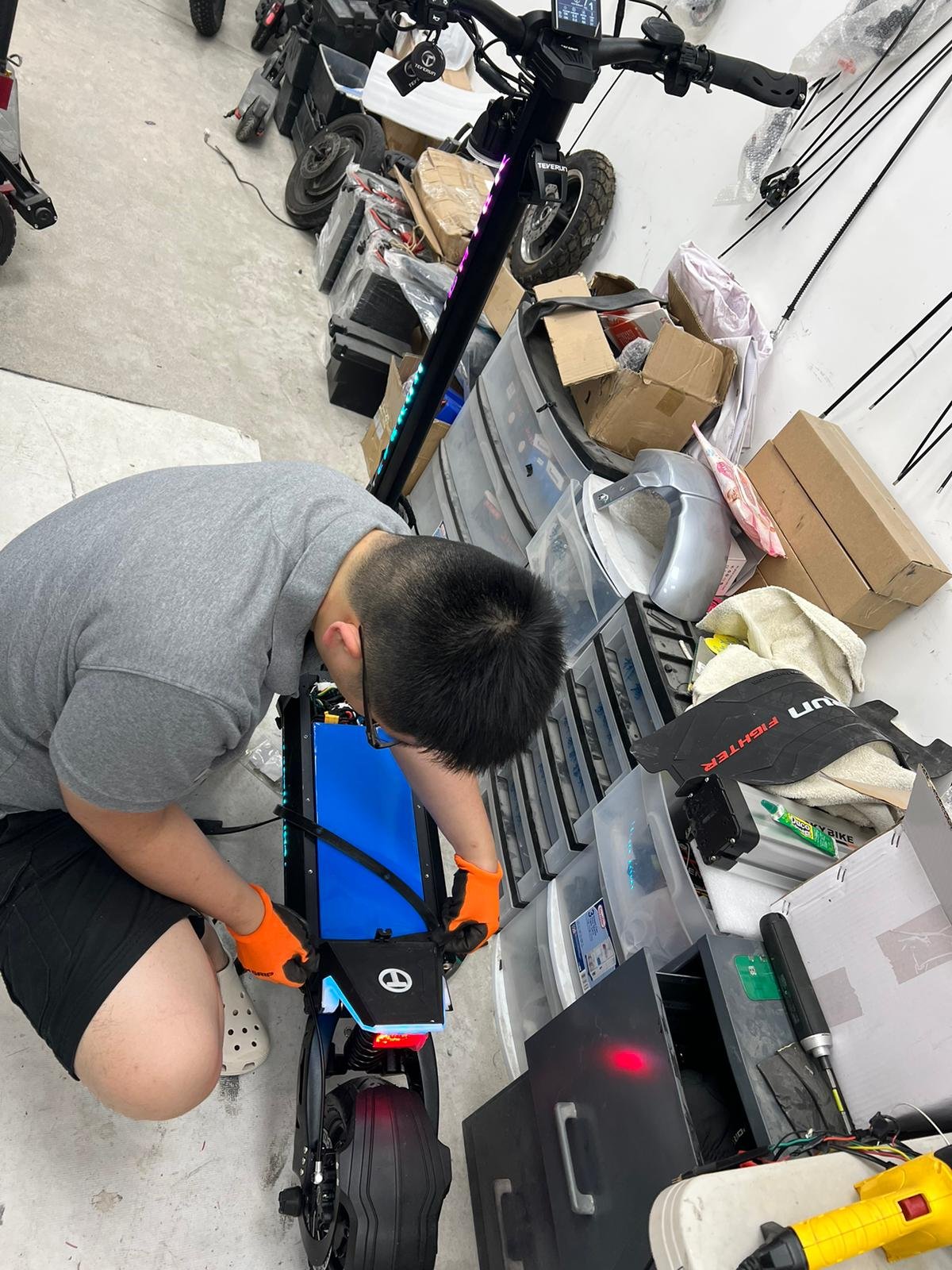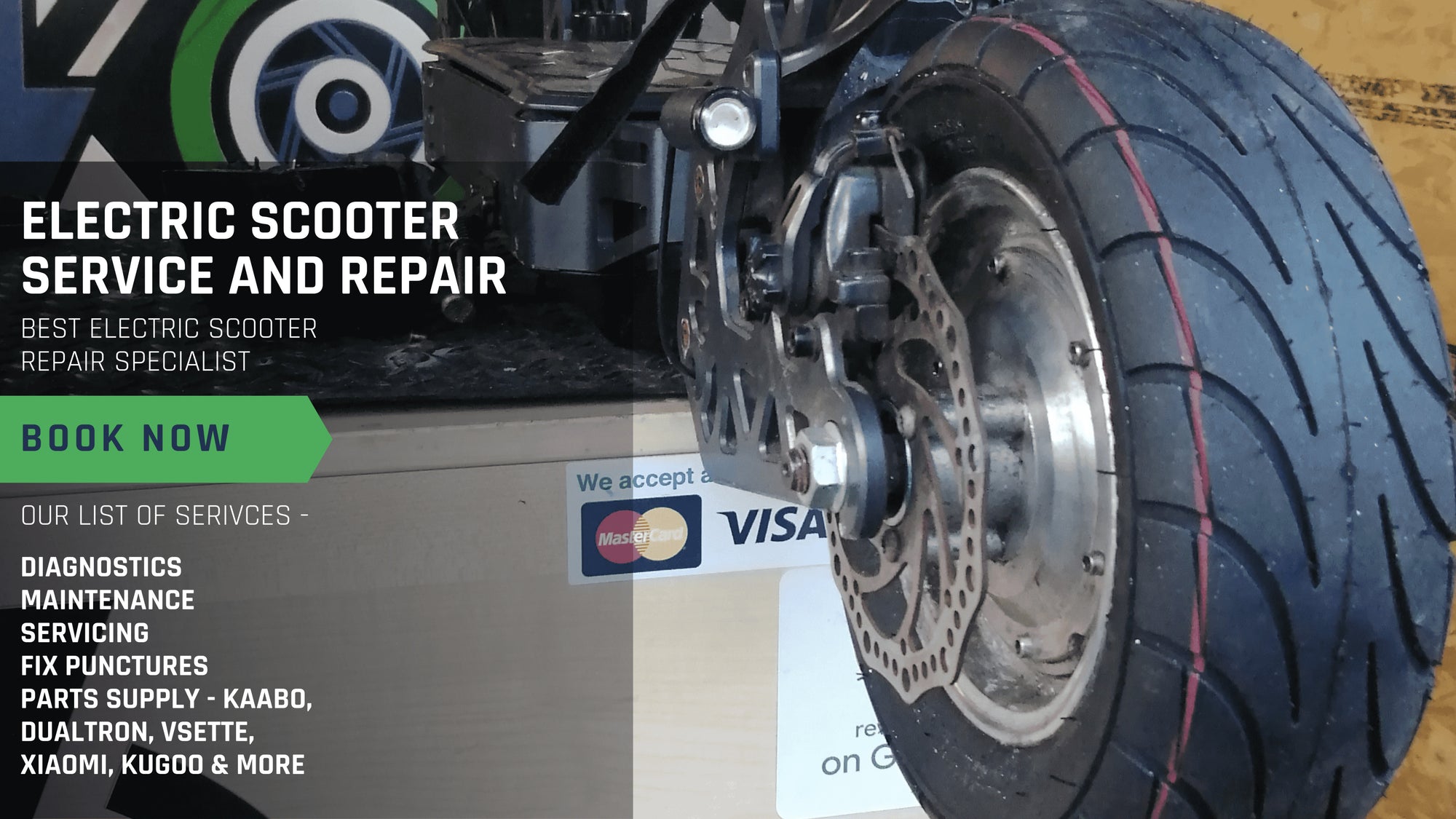Electric scooter repair involves diagnosing and fixing mechanical or electrical issues. Regular maintenance ensures safety and longevity.
Electric scooters are increasingly popular for their convenience and eco-friendliness. Over time, these scooters can encounter various issues such as battery problems, brake malfunctions, or tire wear. Addressing these problems promptly can prevent more significant damage and ensure the scooter operates efficiently.
Regular maintenance, including checking tire pressure, battery health, and brake function, is essential. Knowing basic repair techniques can save time and money. For more complex issues, seeking professional help is advisable. Maintaining an electric scooter properly ensures it remains a reliable and sustainable mode of transportation.

Credit: www.mankeel-store.com
Common Electric Scooter Issues
Electric scooters are a popular choice for urban commuting. They are eco-friendly and cost-effective. But, like all machines, they can face issues. Understanding common electric scooter problems helps you fix them quickly. Here, we discuss some frequent issues and their solutions.
Battery Problems
The battery is a crucial part of an electric scooter. Battery problems are common and can affect your scooter’s performance. There are several signs of battery issues:
- Shortened Range: Your scooter doesn’t travel as far as it used to.
- Slow Charging: The battery takes longer to charge.
- No Charge: The battery won’t charge at all.
To troubleshoot battery issues:
- Check Connections: Ensure all wires are connected properly.
- Inspect for Damage: Look for any visible damage on the battery or wires.
- Test the Voltage: Use a multimeter to check the battery voltage.
If the battery is damaged or doesn’t hold a charge, consider replacing it. Regular maintenance can prolong battery life. Always charge your scooter using the correct charger and avoid overcharging.
Motor Issues
Motor problems can affect the scooter’s speed and performance. Common motor issues include:
- Unusual Noises: Strange sounds coming from the motor.
- Overheating: The motor becomes excessively hot.
- Loss of Power: The scooter slows down or stops.
To identify motor issues:
- Listen for Sounds: Pay attention to any new or unusual noises.
- Check Temperature: Feel the motor to see if it is overheating.
- Inspect Connections: Ensure all motor connections are tight and secure.
If the motor is damaged, it may need professional repair or replacement. Regular cleaning and lubrication can help maintain motor health. Avoid riding your scooter through water or mud to prevent motor damage.
Brake Malfunctions
Brake malfunctions can be dangerous. It’s essential to address them immediately. Common brake issues include:
- Squeaking Brakes: Brakes make noise when used.
- Reduced Stopping Power: The scooter takes longer to stop.
- Loose Brake Levers: The brake levers feel loose or unresponsive.
To fix brake issues:
- Adjust Brake Cables: Tighten or loosen the brake cables as needed.
- Clean Brake Pads: Remove any dirt or debris from the brake pads.
- Inspect for Wear: Check if the brake pads or discs are worn out.
If the brakes are still not working properly, replace the brake pads or get professional help. Regular checks and maintenance can prevent brake issues. Always ensure your scooter’s brakes are in good condition before riding.

Credit: myelectricscooterz.com
Tools Needed For Repairs
Electric scooters are a great way to get around, but they sometimes need repairs. Whether you’re fixing a flat tire or adjusting the brakes, having the right tools is essential. This guide will help you understand the tools needed for electric scooter repairs, ensuring your scooter is always in top shape.
Basic Tools
Every electric scooter owner should have a set of basic tools. These tools handle most common repairs and maintenance tasks.
Here’s a list of basic tools you should have:
- Screwdrivers: Both flathead and Phillips screwdrivers are necessary.
- Allen Wrenches: These are essential for tightening and loosening bolts.
- Adjustable Wrench: Useful for handling various nuts and bolts.
- Tire Pump: Keep your tires properly inflated for a smooth ride.
- Pliers: Needle-nose pliers help in gripping and cutting wires.
Having these tools will allow you to perform routine maintenance and minor repairs. For instance, a tire pump is crucial for maintaining the tire pressure. Proper tire pressure ensures a safe and smooth ride.
An adjustable wrench is versatile. You can use it for different bolt sizes, making it a must-have in your toolkit.
In summary, these basic tools are indispensable for anyone who owns an electric scooter. They cover most of the general maintenance tasks you’ll encounter.
Specialized Tools
While basic tools cover most repairs, some tasks require specialized tools. These tools are designed specifically for electric scooters.
Here are some specialized tools you might need:
- Multimeter: Useful for diagnosing electrical issues.
- Chain Breaker: Needed for adjusting or replacing the scooter chain.
- Tire Levers: Helps in removing and installing tires easily.
- Torque Wrench: Ensures bolts are tightened to the right specifications.
- Battery Tester: Checks the health of your scooter’s battery.
Specialized tools make complex repairs easier. For example, a multimeter helps in diagnosing electrical issues. This tool can check the battery voltage and other electrical components.
A torque wrench is another important tool. It ensures that bolts are tightened to the correct specifications, preventing over-tightening or under-tightening.
These specialized tools are essential for more advanced repairs. They ensure your electric scooter runs smoothly and safely.
Step-by-step Repair Guide
Electric scooters offer a convenient and eco-friendly way to travel, but like any vehicle, they require occasional maintenance. Our Step-by-Step Repair Guide will help you troubleshoot and fix common issues with your electric scooter. Whether you’re dealing with a faulty battery, broken motor, or misaligned brakes, this guide will walk you through the repair process.
Identifying The Problem
Before you can fix your scooter, you need to know what’s wrong. Start by conducting a thorough inspection. Here are some steps to help you identify the problem:
- Check for visible damage such as cracks or broken parts.
- Listen for unusual noises when the scooter is running.
- Test the battery level and charging capacity.
- Examine the brakes and ensure they are responsive.
- Inspect the motor for any signs of wear or damage.
If you are unsure, refer to the scooter’s manual for common issues and solutions. This initial diagnosis will save you time and effort in the long run.
Replacing A Faulty Battery
A faulty battery is a common issue that can affect your scooter’s performance. Follow these steps to replace it:
- Turn off the scooter and remove the battery compartment cover.
- Disconnect the old battery’s wires carefully.
- Take out the old battery and dispose of it properly.
- Insert the new battery, ensuring it fits snugly in the compartment.
- Reconnect the wires to the new battery.
- Replace the battery compartment cover and secure it.
Always use a battery that is compatible with your scooter model. A new battery can significantly improve your scooter’s range and performance.
Fixing A Broken Motor
A broken motor can halt your scooter in its tracks. Here’s how to fix it:
- Turn off the scooter and remove the motor cover.
- Inspect the motor for visible damage or burnt components.
- If necessary, disconnect the motor from the scooter’s wiring.
- Remove the motor from its housing.
- Install the new motor, ensuring it aligns properly with the gears.
- Reconnect the wiring and secure the motor in place.
- Replace the motor cover and test the scooter.
Ensure you purchase a motor compatible with your scooter model. Replacing the motor can restore your scooter’s speed and power.
Adjusting Brakes
Properly functioning brakes are crucial for safety. Follow these steps to adjust the brakes:
- Turn off the scooter and locate the brake adjustment screws.
- Loosen the screws slightly to adjust the brake pads.
- Move the brake pads closer or further from the wheel as needed.
- Tighten the adjustment screws once the pads are in the correct position.
- Test the brakes by rolling the scooter and applying the brake lever.
- Repeat the process if the brakes are still not responsive.
Regularly check and adjust your scooter’s brakes to ensure safe operation. Well-adjusted brakes can prevent accidents and improve ride quality.
Preventative Maintenance
Keeping your electric scooter in top condition is essential for a smooth and safe ride. Preventative maintenance can save you time and money by avoiding costly repairs. Simple tasks like cleaning, checking tire pressure, and lubricating moving parts can extend the life of your scooter.
Regular Cleaning
Regular cleaning is crucial for maintaining your electric scooter. Dirt and debris can cause wear and tear over time. Here’s how to keep your scooter clean:
- Wipe down the scooter with a damp cloth.
- Use a mild detergent for stubborn stains.
- Avoid using high-pressure water.
- Dry the scooter thoroughly to prevent rust.
Cleaning the scooter regularly helps identify potential issues early. Inspect the brake pads and wheels for damage. Keep the handlebars and display screen clean for better visibility and control.
Checking Tire Pressure
Checking tire pressure is vital for a safe and efficient ride. Low tire pressure can lead to poor handling and increased wear. Here’s a simple guide to check your tire pressure:
- Use a reliable tire gauge.
- Refer to the scooter’s manual for the recommended pressure.
- Adjust the pressure accordingly.
Maintaining the correct tire pressure ensures better grip and smoother rides. It also improves battery efficiency. Check the tires for any punctures or cuts while you’re at it.
Lubricating Moving Parts
Lubricating moving parts reduces friction and wear. Essential parts to lubricate include:
- Brake levers
- Chain (if applicable)
- Folding mechanism
Use a suitable lubricant and apply it sparingly. Wipe off any excess to prevent dirt buildup. Regular lubrication keeps the scooter running smoothly and extends the life of its components.
Troubleshooting Tips
Electric scooters are great for short commutes and eco-friendly travel. But like any vehicle, they can run into issues. Knowing some basic troubleshooting tips can help you keep your scooter in top shape. Here are some key areas to check if your scooter isn’t working as it should.
Testing The Battery
A dead or weak battery can cause many problems. Always start by testing the battery. Follow these steps:
- Check the charge level: Use a multimeter to see if the battery is fully charged.
- Inspect for damage: Look for any signs of wear or leaks.
- Test the voltage: A fully charged battery should read 36V or 48V, depending on the model.
If the battery is low, charge it fully. If it doesn’t hold a charge, you may need a new one. Below is a table showing common battery problems and solutions:
| Problem | Possible Cause | Solution |
|---|---|---|
| Battery not charging | Faulty charger | Replace the charger |
| Battery drains quickly | Old battery | Replace the battery |
| No power | Disconnected wires | Reconnect wires |
Checking Electrical Connections
Loose or damaged wires can stop your scooter from working. Follow these tips to check the electrical connections:
- Inspect all wires: Look for loose, frayed, or broken wires.
- Check connectors: Make sure all connectors are tight and free from corrosion.
- Test the throttle: Use a multimeter to check if it’s sending the right signals.
Repair or replace any damaged wires or connectors. Clean dirty connectors with a contact cleaner. Below is a list of tools you might need:
- Multimeter
- Contact cleaner
- Wire cutters
- Electrical tape
Keeping your electrical connections in good shape will ensure a smooth ride.
Inspecting The Brake Pads
Worn brake pads can make your scooter unsafe. Here’s how to check and fix them:
- Check pad thickness: Pads should be at least 1.5mm thick.
- Look for wear: Uneven wear can indicate alignment issues.
- Test the brakes: Squeeze the brake lever and listen for any squeaking or grinding noises.
If the pads are worn, replace them. Here’s a simple guide:
- Remove the wheel.
- Take out the old brake pads.
- Insert the new pads.
- Reattach the wheel and test the brakes.
Regularly inspecting the brake pads will help you ride safely and avoid accidents.

Credit: www.wilsonebikes.com
When To Seek Professional Help
Electric scooters are a great way to get around town. They are eco-friendly, cost-effective, and fun to ride. But what happens when your scooter needs repairs? Knowing when to seek professional help is crucial for keeping your ride smooth and safe. Here are some situations when you should consider professional electric scooter repair.
Complicated Repairs
Some issues with electric scooters are too complex for DIY fixes. Electrical problems, motor issues, and brake malfunctions often require specialized knowledge and tools. Attempting to fix these on your own can lead to more damage.
Here are some signs that a repair is complicated:
- Intermittent power loss
- Strange noises from the motor
- Unresponsive brakes
A professional repair shop will have the right diagnostic tools. They can quickly identify and fix the issue. This saves you time and ensures your scooter is safe to ride. A complex repair often involves:
| Issue | Professional Solution |
|---|---|
| Battery Problems | Battery Testing and Replacement |
| Electrical Failures | Wiring Inspection and Repair |
| Brake Issues | Brake Adjustment and Replacement |
Safety Concerns
Safety should always be a top priority. If your electric scooter shows signs of severe wear or potential hazards, it’s best to consult a professional. Faulty brakes, loose steering, or worn-out tires can pose serious risks.
Here are some situations where professional help is necessary:
- Brakes not engaging properly
- Steering feels loose or unresponsive
- Tires are visibly worn or damaged
Professionals can ensure that all safety features are functioning correctly. They can inspect and replace parts to meet safety standards. This helps prevent accidents and keeps you safe on the road. Safety concerns that need professional attention include:
| Issue | Professional Solution |
|---|---|
| Brake Malfunction | Brake System Overhaul |
| Steering Problems | Steering Column Tightening |
| Worn Tires | Tire Replacement |
Warranty Coverage
If your electric scooter is still under warranty, attempting repairs on your own can void it. Warranty coverage often includes repairs for specific issues, provided they are performed by authorized technicians.
Here are some benefits of utilizing your warranty:
- Cost-effective repairs
- Guaranteed workmanship
- Use of original parts
Authorized service centers have technicians trained by the manufacturer. They follow specific guidelines to ensure your scooter remains in good condition. Warranty-covered repairs often include:
| Issue | Covered Repair |
|---|---|
| Battery Failure | Free Battery Replacement |
| Motor Issues | Motor Repair or Replacement |
| Electrical Problems | Wiring and Circuit Repair |
Diy Vs Professional Repairs
Electric scooters have become a popular mode of transportation. They are eco-friendly, economical, and fun. But like any vehicle, they can break down. Deciding between DIY repairs and professional repairs can be challenging. Each option has its own benefits and drawbacks. Let’s explore them.
Cost Comparison
Cost is a significant factor in deciding whether to repair your electric scooter yourself or hire a professional. DIY repairs can be cheaper, especially if you already have the necessary tools.
- DIY Repairs: You only pay for parts and tools. Labor is free since you’re doing it yourself.
- Professional Repairs: You pay for parts, labor, and possibly diagnostic fees.
Here’s a simple cost comparison table:
| Repair Type | Cost |
|---|---|
| DIY | $20 – $100 (parts and tools) |
| Professional | $50 – $300 (parts, labor, diagnostics) |
DIY repairs can save you a lot of money. But if you make a mistake, it could become more expensive in the long run. Professional repairs are more costly but usually come with a warranty. This can save you money if something goes wrong again.
Time Commitment
Time is another critical factor. DIY repairs can take a lot of time, especially if you’re not familiar with the process.
- DIY Repairs: You need time to diagnose the problem, buy parts, and do the repair. This could take several hours or even days.
- Professional Repairs: You drop off your scooter and wait for the shop to call you. This could be faster or slower, depending on the shop’s schedule.
Here’s a simple time comparison table:
| Repair Type | Time Commitment |
|---|---|
| DIY | Several hours to days |
| Professional | 1 day to a week |
If you have a busy schedule, professional repairs can be more convenient. But if you enjoy tinkering and have the time, DIY repairs can be a rewarding experience.
Skill Level Required
The skill level required for repairing an electric scooter varies. Some repairs are simple and can be done by anyone. Others are complex and require professional skills.
- DIY Repairs: You need basic mechanical skills and some knowledge of electric systems. Online tutorials and manuals can be helpful.
- Professional Repairs: Professionals have the training and experience to handle complex issues. They can diagnose and fix problems that you might not even notice.
Here’s a simple skill level comparison table:
| Repair Type | Skill Level |
|---|---|
| DIY | Basic to Intermediate |
| Professional | Advanced |
If you’re confident in your skills, DIY repairs can be a great option. But if you’re unsure or the problem is complex, professional repairs are the safer choice.
Frequently Asked Questions
Are Electric Scooters Fixable?
Yes, electric scooters are fixable. Many common issues can be repaired, including battery, motor, and brake problems. Regular maintenance helps.
Why Has My Electric Scooter Stopped Working?
Your electric scooter might have stopped working due to a dead battery, loose connections, or a blown fuse. Check these components first.
How To Fix Electric Scooter Stem?
Tighten loose bolts on the stem using a wrench. Replace damaged parts if necessary. Ensure all components are secure.
How To Fix A Motor On An Electric Scooter?
First, turn off the scooter. Remove the deck to access the motor. Check connections and wiring for damage. Replace or repair as needed. Reassemble the scooter and test.
Conclusion
Maintaining your electric scooter ensures safety and longevity. Regular checks and timely repairs prevent bigger issues. Equip yourself with basic repair skills or consult professionals. Keep your scooter in top condition for a smoother ride. Prioritize maintenance to enjoy hassle-free journeys every time you ride.
Happy scooting!




